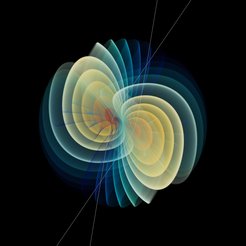Precise modelling of high-speed black hole encounters
Applying abstract mathematical structures to real-world phenomena provides new insights into gravitational waves
An international team of researchers, including scientists from the Max Planck Institute for Gravitational Physics in the Potsdam Science Park, is setting new standards for modeling the encounter of black holes at very high speeds.

The new method is based on – so far – abstract mathematical structures, called Calabi-Yau spaces. Applying them to real astrophysical phenomena leads to highly accurate predictions of how black holes and neutron stars are deflected from their initial orbits after their encounter.
The paper, published today in Nature, comes at the right time to meet the growing demand for highly accurate theoretical predictions.
The results could be used to detect gravitational-wave signals in future observing runs of the current network of gravitational-wave detectors, with the planned third generation of ground-based observatories such as the Einstein Telescope and Cosmic Explorer, and with the space-borne Laser Interferometer Space Antenna (LISA).












